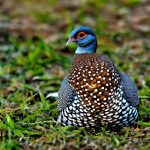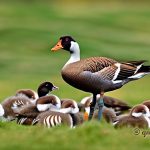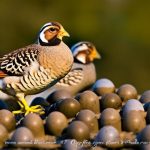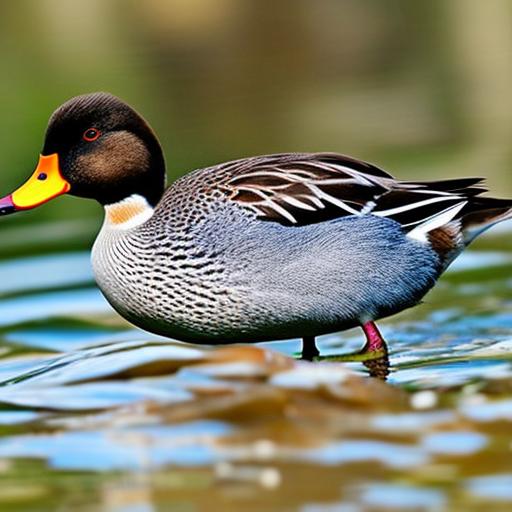Ever caught yourself gazing out at a pond and spotting ducks cozily paired up, leaving you to wonder when these charming birds shift into full-on family mode? You’re certainly not the only one! Both duck owners and wildlife watchers share this curiosity about when exactly our quacking companions start their amorous adventures.
And truth be told, there’s something utterly captivating about witnessing nature’s very own love ballet.
Standing by my own pond, I’ve often mused over my feathery friends’ pairing antics with equal parts fascination and empathy. When do ducks really decide that it’s time for romance? Diving beak-first into the enchanting realm of waterfowl courtship, I’ve come to find that most species begin forming bonds in the winter months, from December through March.
This guide will escort you through every step of a duck’s mating dance—from those quirky yet endearing courtship rituals through to the search for the perfect nesting haven—a journey sure to enrich your appreciation for these winged wonders during their breeding period.
Get ready—what you’re about to learn is as delightful and entertaining as it is informative. Trust me; you might just find yourself chuckling along with the quacks!
Understanding Duck Mating Habits
Duck mating habits are influenced by environmental factors and follow distinct breeding seasons. Understanding the behavioral patterns of ducks during mating provides insight into their reproductive process.
Behavioral Patterns of Ducks During Mating
Ducks show fascinating behaviors when they’re ready to mate. Male ducks start by showing off their bright feathers and performing special moves to catch a female’s attention. They swim in front of her, bobbing their heads up and down, or even flying across her line of sight.
Females watch these displays closely. If she likes what she sees, the female will signal back with her body position or quacks. Soon after pairing up, the couple starts spending a lot of time together, swimming side by side.
Mating rituals are key for duck pairs during breeding season. These courtship dances strengthen their bond before they go on to lay eggs and raise ducklings together. As spring arrives with warmer weather and more food around, you can spot these patterns more often among ducks getting ready to start families.
The Breeding Seasons
During the breeding season, ducks exhibit specific behaviors and mating patterns that are essential to understand as a duck keeper.
- Ducks do not mate year – round. Instead, they rely on favorable weather and abundant food resources of spring and summer to initiate their mating process.
- Wild Mallards, as well as domesticated ducks, have season – dependent mating behaviors that correspond to the availability of resources.
- Most species of ducks typically form bonded pairs for mating during the breeding season, with new pairs forming each breeding season.
- The mating season for ducks in North America generally occurs between December and March, varying slightly depending on the species of duck present.
- Courtship displays play a crucial role in recognizing duck mating behaviors and understanding their reproductive habits.
Environmental Factors that Influence How Ducks Mate
Ducks are influenced by various environmental factors when it comes to mating. Changes in daylight and temperature trigger hormonal shifts, which signal the start of their breeding season.
The availability of suitable nesting sites near water bodies is crucial for ducks to mate successfully. Additionally, weather conditions such as heavy rainfall can impact the timing and success of mating by influencing the accessibility and quality of nesting areas.
The presence of predators also plays a significant role in duck mating behavior. Ducks tend to select safer environments with minimal threats for courtship displays and egg-laying activities.
The Reproductive Process of Ducks
Male and female ducks have different reproductive systems, with the males having a phallus for mating. Signs that a duck is ready to mate include increased vocalization and courtship displays.
Understanding these behaviors can help in successful breeding management.
Male and Female Duck Reproductive Systems
Male ducks have an external sexual organ called a phallus, which is normally concealed inside the body. Their reproductive system consists of testes, epididymides, and vas deferens.
Female ducks have a unique reproductive anatomy; their oviducts are capable of forming protective shells around eggs. They also possess a specialized gland called the uropygial gland that secretes oil to waterproof their feathers during incubation.
The male duck’s cloaca swells and protrudes during mating season to facilitate successful copulation. This part differs significantly from the female equivalent, whose cloaca has an opening that plays significant roles in reproduction as it serves as the exit for eggs and waste products.
Signs That A Duck Is Ready To Mate
I’ve observed some clear signs that indicate a duck is ready to mate. Here’s what I’ve noticed:
- The female duck becomes more vocal, often quacking loudly and frequently.
- Both male and female ducks engage in preening activities, showing off their plumage to attract a mate.
- The female exhibits receptive behavior by lowering her head and body while wagging her tail.
- The male duck may display protective behaviors around the female, positioning himself between her and any perceived threats.
- Ducks start engaging in courtship displays, such as head-pumping or tail-wagging movements.
Duck Courtship Displays
During courtship, ducks perform various displays to attract a mate. These include head bobbing, tail wagging, and preening. The male might also chase the female in an attempt to impress her.
These behaviors are crucial for identifying potential mates and establishing pair bonds before mating.
Observing these courtship displays can provide valuable insight into the reproductive habits of ducks. It’s important for duck keepers to recognize these behaviors as they signal that mating season is approaching or underway.
Strategies for Successful Mating
Establishing territories, developing courtship displays, finding the right nesting site, and providing protection are essential strategies for successful duck mating. If you want to learn more about these strategies and how they contribute to the reproductive success of ducks, keep reading!
Establishing Territories
To ensure successful duck mating, it’s crucial to understand the significance of establishing territories. Ducks establish territories by marking their chosen nesting sites with specific scents and sounds to warn off intruders.
- Ducks use body language, such as head pumping and tail wagging, to communicate territorial boundaries.
- They also emit specific calls to assert their ownership of an area, deterring other ducks from encroaching.
- Territorial displays may include aggressive behavior like chasing or pecking, which helps solidify boundaries.
- Dominant ducks are more successful in securing prime territories, which are essential for successful mating and raising ducklings.
- Understanding the territorial behavior of ducks is important for maintaining a harmonious environment for mating and breeding.
Developing Courtship Displays
To ensure successful duck mating, understanding courtship displays is crucial.
- Courtship displays are exhibited by male ducks as a way to attract females.
- This can include head bobbing, tail wagging, and vocalizations to impress potential mates.
- Male ducks may also perform intricate water dances involving splashing and wing flapping.
- The complexity and vigor of courtship displays can vary based on the species of duck.
- Familiarizing yourself with the specific courtship behaviors of your duck’s breed is essential for successful mating.
- Observing courtship displays allows you to identify when mating is likely to occur.
- It’s important to provide an environment that encourages these behaviors, such as access to water and space for energetic displays.
- Recognizing and appreciating these courtship displays fosters a better understanding of the reproductive habits of ducks.
- By acknowledging and facilitating natural behavior, you can support the successful mating and reproduction of your ducks.
- Understanding courtship displays helps in creating enriching environments for ducks in captivity.
Finding the Right Nesting Site
To find the right nesting site for your ducks, consider these factors:
- Look for a location near water: Ducks prefer nesting near water bodies like ponds or wetlands, providing easy access to food and safety from predators.
- Provide vegetation cover: Choose a site with dense vegetation to offer shelter and concealment for the nesting ducks.
- Ensure nesting material availability: Select an area with ample natural materials such as reeds, grass, and twigs for building nests.
- Avoid disturbances: Pick a quiet spot away from human activity and potential disturbances to minimize stress on the nesting ducks.
- Consider predator protection: Set up the nesting site in a location that is less accessible to ground-based predators to ensure the safety of the eggs and ducklings.
Providing Protection
To ensure successful duck mating, it’s important to provide protection. This includes:
- Creating a safe and secure nesting environment to protect the eggs and ducklings from predators.
- Setting up fencing or barriers around the nesting area to prevent access by potential threats like raccoons, foxes, or cats.
- Using scare devices such as decoy predators or reflective items to deter predators from approaching the nesting site.
- Monitoring the nesting area regularly to identify and address any potential risks or disturbances that could threaten the safety of the ducks.
- Providing a source of clean water for bathing and drinking, which is essential for maintaining good health and protecting against diseases.
Common Misconceptions
Contrary to popular belief, ducks do not always mate for life and may change partners. Additionally, while ducks spend a lot of time in water, they often engage in mating activities on land or near the water’s edge.
Do Ducks Mate for Life?
Ducks do not mate for life. Most species of ducks form new pair bonds each year during the breeding season, which typically occurs between March and May. This means that they will find a different mate each year for the purpose of mating and raising their offspring.
The period between December and March is when these pair bonds are formed on the wintering grounds, maintaining only through egg laying, after which new pairs may form in subsequent breeding seasons.
Understanding this behavior is crucial for duck keepers to know that ducks do not have lifelong mates. This insight helps us care for them better in captivity while respecting their natural mating habits.
Do Ducks Mate in Water?
During the mating season, ducks often mate on land near water bodies rather than in the water itself. They choose secure locations for their nests and courtship displays are more commonly observed on dry ground.
Although ducks spend much of their time in or around water, they tend to engage in the actual mating process on solid ground.
Water serves as a crucial element for ducks during mating but is not typically where mating takes place. Instead, it’s important for providing suitable conditions for nesting and raising ducklings once the eggs have been laid.
The Importance of Understanding Duck Mating for Conservation Efforts
Understanding the mating habits of ducks is crucial for conservation efforts. By knowing when and how ducks mate, we can better protect their breeding habitats and ensure the survival of their populations.
It also helps in making informed decisions about population management and habitat preservation.
Role of Mating in the Duck Population
Mating plays a crucial role in maintaining the duck population. It ensures the continuation of the species and contributes to genetic diversity. The natural mating behaviors, courtship displays, and bonding between pairs during the breeding season are essential for successful reproduction.
Pair bonds formed during mating support the raising of offspring, providing protection and stability. Understanding these behaviors helps conservation efforts by recognizing optimal habitats for breeding and nesting sites.
Conserving areas that support healthy duck populations during mating seasons is vital for sustaining their numbers and preserving biodiversity.
Considerations for Conservation Efforts
To conserve duck populations, I suggest the following:
- Ensure habitat preservation in breeding areas to support nesting and rearing of ducklings.
- Promote wetland conservation and restoration activities to maintain suitable mating grounds for ducks, which are essential for their reproductive success.
- Implement measures to minimize disturbances during the breeding season, such as avoiding human intrusion in nesting areas.
- Support research and monitoring programs to gather data on duck populations, reproductive success, and factors influencing mating behaviors.
Conclusion
In summary, understanding duck mating habits is crucial for successful breeding. The practical strategies discussed, such as establishing territories and providing protection, are efficient and easy to implement.
Have you observed any courtship displays that indicate duck mating behaviors? Consider how applying these methods can impact conservation efforts. Explore additional resources to deepen your knowledge on duck reproductive biology.
Reflecting on the importance of duck mating rituals can inspire proactive steps towards effective preservation.
FAQs
1. When does duck breeding season start and how long does it last?
Duck mating season usually begins in early spring and can last until the end of summer, depending on the duck species and their habitat.
2. What are some courtship displays ducks perform during mating season?
During mating season, ducks show off with special moves called courtship displays to attract mates, like head-bobbing and making loud quacks or whistles.
3. How do ducks choose their partners for breeding?
Ducks often pick their partners based on attractive feather colors, strong courtship displays, or good nesting spots which helps them form pair bonds before laying eggs.
4. Do all ducks have the same nesting habits?
Nope! Different kinds of ducks have different ways of nesting; some hide their nests in tall grass while others might use a hole in a tree or build floating nests on water.
5. Can you tell me about the fertility cycle of ducks?
Sure! Once paired up after the waterfowl pairing behavior rituals, female ducks lay eggs and stay fertile for several weeks to make sure they can raise as many ducklings as possible each season.
Meet Walter, the feathered-friend fanatic of Florida! Nestled in the sunshine state, Walter struts through life with his feathered companions, clucking his way to happiness. With a coop that’s fancier than a five-star hotel, he’s the Don Juan of the chicken world. When he’s not teaching his hens to do the cha-cha, you’ll find him in a heated debate with his prized rooster, Sir Clucks-a-Lot. Walter’s poultry passion is no yolk; he’s the sunny-side-up guy you never knew you needed in your flock of friends!







